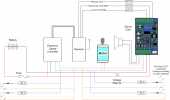The Rx45 is a 3-6V 500mA device.
I think you would exceed this limit if you were to stall the loco. - I believe you have both R1 and grades on your line?
It is also a tiny device, so you would probably have to decide what you wanted before ordering, so that it could be supplied pre-wired?
If you want sound, you are going to need a higher supply voltage for the sound card, so you would be fitting within the body, and space should not be at a premium.
The MR001a has pins for connection, giving you flexibility to experiment, without resorting to the soldering iron.
The ESC would give you the flexibility to swap to a bigger battery, if this proved necessary. - Tight curves, grades, a larger loco, and sound. All will add to the current draw, reducing your running time.
PhilP

